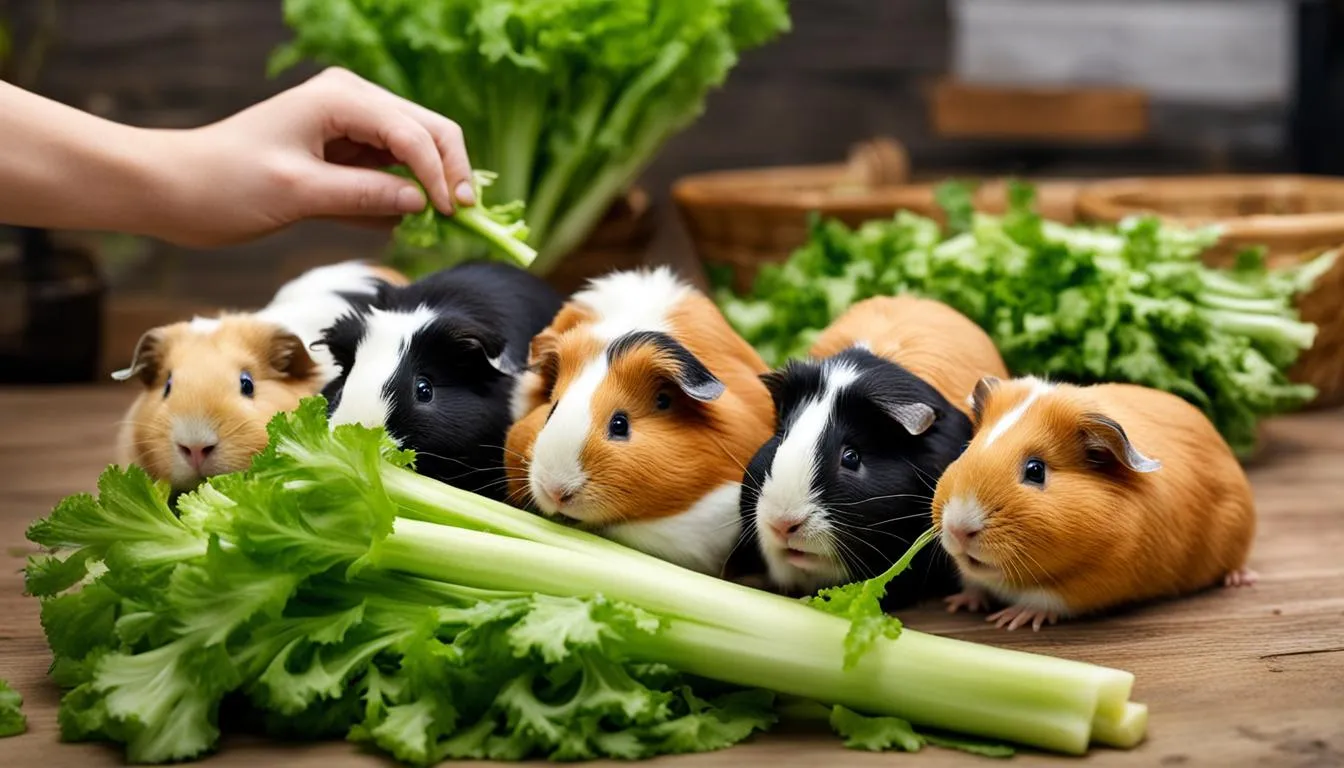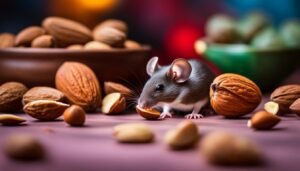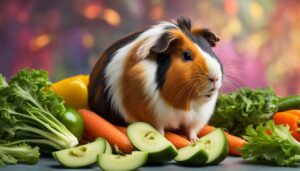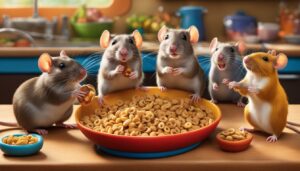Guinea pigs make adorable and lovable pets, and as responsible pet owners, we always strive to provide them with the best care and nutrition.
So, when it comes to feeding our furry friends, it’s important to know what foods are safe and beneficial for them. One such question that often pops up is, “Can guinea pigs eat celery?”
Well, the good news is that guinea pigs can indeed enjoy the occasional celery treat. Celery, with its crunchy texture and refreshing taste, can be a healthy addition to their diet.
It contains various vitamins and antioxidants that can provide health benefits to our little companions.
However, it’s crucial to keep in mind that celery should be given in moderation and not as a staple food.
Like any other food, improper consumption can lead to potential issues, so it’s important to follow some guidelines to ensure the well-being of our guinea pigs.
Key Takeaways
- Guinea pigs can eat celery, but it should not be a main component of their diet.
- Celery is a good source of vitamins and antioxidants that can benefit guinea pigs.
- Cutting celery into small pieces is necessary for easier digestion.
- Excessive consumption of celery can lead to diarrhea and urinary issues.
- Introduce celery gradually and observe your guinea pig for any adverse reactions.
The Importance of a Balanced Diet for Guinea Pigs
A balanced diet is crucial for the overall health and well-being of guinea pigs. It is important to provide them with a variety of foods that meet their nutritional needs.
A proper guinea pig diet should consist of pellets, hay, and fresh vegetables.
Pellets: Guinea pigs should be given high-quality pellets that are specifically formulated for their dietary needs.
These pellets should be fortified with vitamin C, as guinea pigs cannot synthesize this vitamin on their own.
However, pellets should be given in moderation as they can be high in calories, and excessive consumption can lead to weight gain.
Hay: Hay is an essential part of a guinea pig’s diet and should make up around 80% of their daily food intake.
It aids in digestion, helps maintain healthy teeth, and provides important nutrients. Timothy hay is recommended for adult guinea pigs, while alfalfa hay is more suitable for young guinea pigs and pregnant or nursing guinea pigs.
| Foods | Frequency |
|---|---|
| Hay | Available at all times |
| Pellets | 1/8 to 1/4 cup per day |
| Fresh Vegetables | About 1 cup per day |
Fresh Vegetables: Fresh vegetables should be given daily to provide guinea pigs with additional vitamins and minerals.
Leafy greens like romaine lettuce, kale, and parsley should be the main components of their vegetable intake.
Other suitable options include bell peppers, cucumbers, and zucchini. It is important to introduce new vegetables gradually to prevent digestive upset.
Avoid feeding guinea pigs vegetables that are high in oxalic acid, such as spinach and Swiss chard.
In addition to these main components, guinea pigs can also be given occasional treats in the form of small amounts of fruits.
However, fruits should be given sparingly due to their high sugar content. Always wash fruits and vegetables thoroughly before feeding them to your guinea pig to remove any pesticides or dirt.
The Health Benefits of Celery for Guinea Pigs
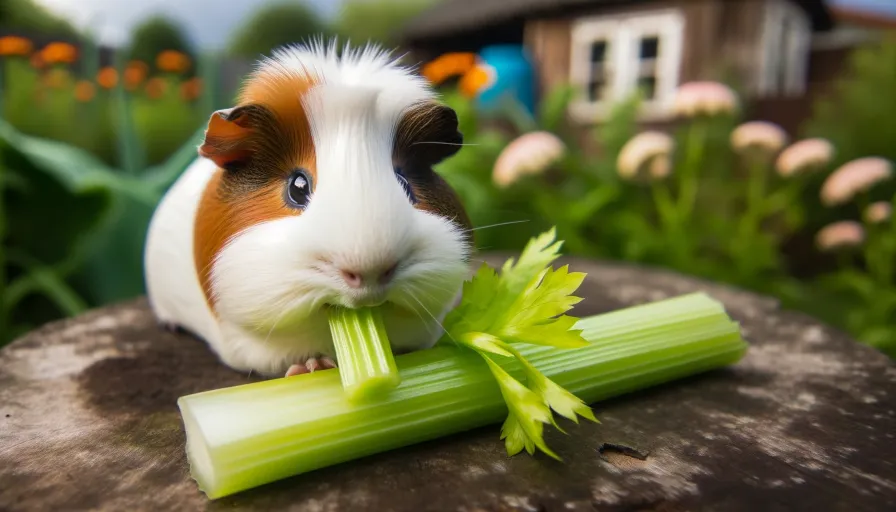
Celery offers several health benefits for guinea pigs. It is packed with antioxidants and vitamins, such as vitamin A and vitamin C, which can improve their eyesight and boost their immune system.
The anti-inflammatory properties of celery can also help reduce inflammation in their digestive tract and keep their vital organs and blood vessels healthy.
Additionally, celery is low in calories and can provide hydration due to its high water content. However, it’s important to remember that celery should be given as a treat and not as a primary source of nutrition for guinea pigs.
When adding celery to your guinea pig’s diet, it’s crucial to do so in moderation. Too much celery can lead to diarrhea and urinary issues, as it contains calcium and oxalic acid.
To prevent digestive problems, it’s recommended to cut celery into small, bite-sized pieces for easier consumption. Organic celery is also preferred to minimize their exposure to pesticides.
Remember that a balanced diet for guinea pigs consists of hay and pellets as the main components, with fresh vegetables and occasional fruits as supplementary treats.
In summary, while celery can provide health benefits for guinea pigs, it should be given in moderation and as a treat.
Be mindful of their reactions and adjust the portion accordingly. By providing a balanced diet and closely monitoring their well-being, you can ensure your guinea pig remains healthy and happy.
| Health Benefits of Celery for Guinea Pigs | |
|---|---|
| Vitamins | Vitamin A, Vitamin C |
| Antioxidants | Improves eyesight, boosts immune system |
| Anti-inflammatory properties | Reduces inflammation in digestive tract, maintains vital organs and blood vessels |
| Low in calories | Provides hydration due to high water content |
| Caution | Give in moderation to avoid digestive issues, cut into small pieces, choose organic celery |
Potential Risks and Considerations when Feeding Celery to Guinea Pigs
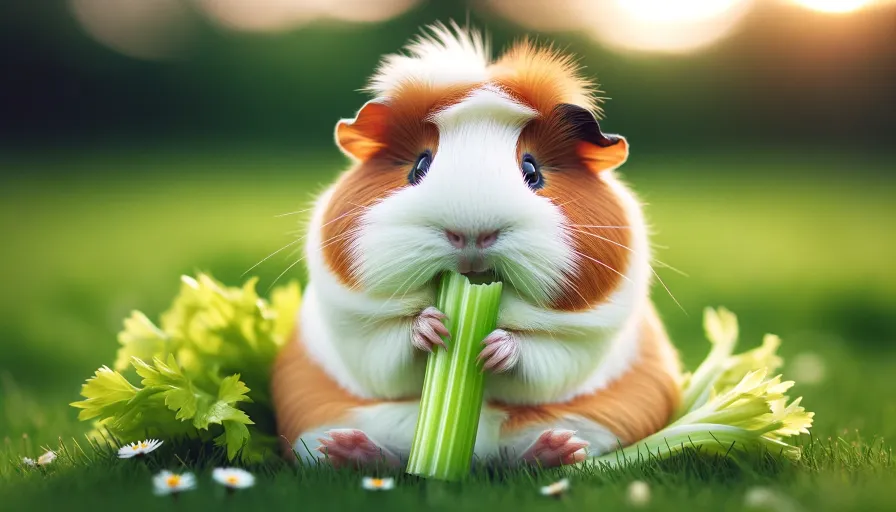
While celery can be a beneficial addition to a guinea pig’s diet, it’s important to be aware of potential risks and considerations.
Guinea pigs may have difficulty chewing the fibrous celery stalks, so it’s crucial to cut them into small pieces for easier consumption.
Feeding excessive amounts of celery to guinea pigs can lead to digestive issues such as diarrhea and urinary problems due to its calcium and oxalic acid content.
When offering celery to your guinea pig, it’s recommended to start with small amounts and gradually increase the serving size.
This approach allows you to monitor your pet for any adverse reactions or digestive discomfort. If you notice any signs of diarrhea or wet stool after your guinea pig consumes celery, it is best to reduce or eliminate it from their diet for a few days.
Consulting with a veterinarian is important, especially if diarrhea persists or worsens, as it can indicate underlying health issues.
It’s also important to choose organic celery and wash it thoroughly to remove any pesticides before feeding it to your guinea pig.
Organic celery reduces the risk of exposing your pet to harmful chemicals. In addition, it’s essential to remember that celery should be given as a treat and not as a primary source of nutrition for guinea pigs.
Providing a balanced diet with hay and pellets as the main components is crucial to meeting their nutritional needs.
| Potential Risks and Considerations when Feeding Celery to Guinea Pigs |
|---|
| Difficulty chewing fibrous celery stalks |
| Excessive consumption may lead to diarrhea and urinary issues |
| Start with small amounts and monitor for adverse reactions |
| Reduce or eliminate celery if diarrhea or wet stool occurs |
| Choose organic celery and wash thoroughly to remove pesticides |
| Celery should be given as a treat, not a primary source of nutrition |
| Provide a balanced diet with hay and pellets as main components |
The Nutritional Value of Celery Stalks for Guinea Pigs
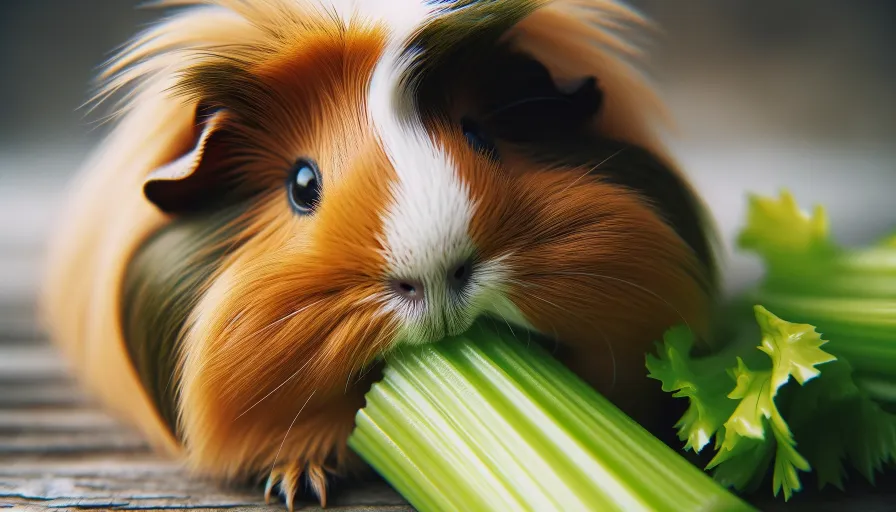
Celery stalks offer a range of nutritional benefits for guinea pigs, making them a suitable addition to their diet.
They are low in calories and fat, making them a healthy snack option. Additionally, celery stalks contain vitamins such as vitamin C, vitamin A, and vitamin K, which are essential for the overall health and well-being of guinea pigs.
These vitamins contribute to improved eyesight, a strengthened immune system, and healthy blood clotting.
Celery stalks also provide important minerals like calcium and potassium, which support proper bone development and muscle function.
While celery stalks are a nutritious option, it’s important to feed them in moderation due to their high water content.
Excessive consumption can lead to digestive issues, such as diarrhea, in guinea pigs. It’s recommended to offer celery stalks as a treat a few times a week, rather than as a main component of their diet.
By doing so, you can provide your furry friend with the nutritional benefits of celery while ensuring their overall well-being.
Nutritional Value of Celery Stalks for Guinea Pigs
| Nutrient | Amount per 100g |
|---|---|
| Calories | 16 |
| Protein | 0.7g |
| Fat | 0.2g |
| Carbohydrates | 3.1g |
| Fiber | 1.6g |
| Vitamin C | 3.1mg |
| Vitamin A | 449IU |
| Vitamin K | 29.3mcg |
| Calcium | 40mg |
| Potassium | 260mg |
As seen in the table above, celery stalks are rich in vitamins and minerals while being low in calories and fat.
They provide a great balance of nutrients for guinea pigs, contributing to their overall health and vitality.
Remember to always introduce new foods gradually and monitor your guinea pig for any adverse reactions or digestive issues.
If you have any concerns about your guinea pig’s diet or health, it’s best to consult with a veterinarian for personalized advice and guidance.
How Often Should You Feed Celery to Your Guinea Pig?
Celery can be a healthy addition to your guinea pig’s diet, but it’s important to feed it in moderation. A few times a week is a suitable frequency to offer celery to your furry friend.
Start with small amounts and gradually increase the serving size to avoid any digestive issues. Remember, celery should be given as a treat and not as a primary source of nutrition.
Observing your guinea pig’s response to celery is crucial. If you notice any signs of diarrhea or wet stool after feeding celery, it’s best to stop and consult with a veterinarian.
These symptoms could indicate that your guinea pig is consuming too much celery or has a sensitivity to it.
Always prioritize your pet’s well-being and adjust their diet accordingly.
Introducing variety in your guinea pig’s diet is important, as it ensures they receive a balanced nutritional intake.
You can mix celery with other vegetables and leafy greens, such as spinach, romaine lettuce, or baby carrots.
By combining different foods, you provide your guinea pig with a range of vitamins and minerals. Remember to introduce new foods gradually and monitor your pet for any negative reactions.
| Veggies | Frequency |
|---|---|
| Celery | 2-3 times a week |
| Spinach | 2-3 times a week |
| Romaine lettuce | Daily |
| Baby carrots | 2-3 times a week |
Remember, every guinea pig is unique, and their dietary needs may vary. Pay attention to their individual preferences and adjust their diet accordingly.
If you have any concerns about your guinea pig’s diet or health, it’s always best to consult with a veterinarian for personalized guidance.
Preparing Celery for Your Guinea Pig
When it comes to feeding celery to your guinea pig, proper preparation is essential to ensure their safety and enjoyment.
Follow these guidelines to prepare celery for your furry friend:
Choosing Fresh Celery
Start by selecting crisp and fresh celery stalks. Look for stalks that are pale to bright green, with no signs of wilting or yellowed leaves.
Fresh celery will provide the best nutritional value for your guinea pig.
Cleaning Thoroughly
Before serving celery to your pet, wash it thoroughly under running water. This will help remove any dirt, pesticides, or other contaminants that may be present on the celery stalks.
Cutting into Bite-Sized Pieces
Next, cut the celery into small, bite-sized pieces. Guinea pigs have smaller mouths, so cutting the celery into smaller pieces will make it easier for them to eat and digest.
This will also help prevent choking hazards.
Once you have prepared the celery, you can offer it to your guinea pig as a delicious and nutritious treat.
Remember to store any uneaten celery in a sealed bag or wrapped in a damp paper towel in the refrigerator’s crisper drawer to keep it fresh for future servings.
| Celery Preparation Steps |
|---|
| Choose fresh celery stalks |
| Wash the celery thoroughly |
| Cut into bite-sized pieces |
Mixing Celery with Other Foods for Your Guinea Pig

When it comes to feeding your guinea pig, offering a variety of foods can help ensure a balanced and nutritious diet.
Mixing celery with other vegetables and leafy greens can provide both flavor and nutritional benefits for your furry friend. Here are some suggestions for foods that pair well with celery:
- Spinach: This leafy green is rich in vitamins and minerals, including vitamin A and iron.
- Romaine lettuce: A hydrating and low-calorie option that provides vitamins A, C, and K.
- Chard: Another leafy green that offers a good source of vitamins A, C, and K, as well as magnesium and potassium.
- Baby carrots: These crunchy treats are high in vitamin A and provide a satisfying chew for your guinea pig.
- Apple slices: A sweet and refreshing option that adds a touch of natural sweetness to the mix.
By combining different foods, you can provide your guinea pig with a diverse range of nutrients.
Remember to introduce new foods gradually and monitor your pet for any negative reactions. If you notice any digestive issues or allergies, it’s best to eliminate the problematic food and consult with a veterinarian if necessary.
Table: Foods to Mix with Celery for Your Guinea Pig
| Food | Nutritional Benefits |
|---|---|
| Spinach | Vitamin A, iron |
| Romaine Lettuce | Vitamins A, C, K |
| Chard | Vitamins A, C, K, magnesium, potassium |
| Baby Carrots | Vitamin A, crunchy texture |
| Apple Slices | Natural sweetness, hydration |
Remember to offer these mixed foods in moderation, alongside hay and pellets, which should make up the majority of your guinea pig’s diet.
Providing a varied and balanced diet will help ensure that your guinea pig receives all the necessary nutrients for optimal health and well-being.
Signs of Excessive Celery Consumption and When to Stop Feeding It
While celery can be a beneficial addition to your guinea pig’s diet, it’s important to monitor their consumption and watch for any signs of excessive intake.
Here are some signs to look out for:
- Diarrhea: Excessive celery consumption can lead to diarrhea in guinea pigs. If you notice loose or watery stool after your guinea pig has eaten celery, it may be a sign that they have had too much. In this case, it’s best to reduce or eliminate celery from their diet for a few days and observe if the symptoms improve.
. - Urinary issues: Celery contains calcium and oxalic acid, which, when consumed in excess, can contribute to urinary issues in guinea pigs. These issues may manifest as difficulty urinating or an increased frequency of urination. If you notice any of these symptoms, it’s important to stop feeding celery and consult with a veterinarian for further guidance.
. - Decreased appetite: If your guinea pig suddenly shows a decreased interest in their food or stops eating altogether after consuming celery, it could be a sign that they have had too much. Monitor their appetite and if the decrease persists, consider removing celery from their diet.
. - Weight loss: Excessive celery consumption can contribute to weight loss in guinea pigs. If you notice that your guinea pig is losing weight even though they are eating, it may be a result of consuming too much celery. Consult with a veterinarian to evaluate their overall health and adjust their diet accordingly.
Remember, every guinea pig is unique, and their tolerance to celery may vary. It’s important to observe your pet closely and make adjustments to their diet as needed.
If you have any concerns about your guinea pig’s health or diet, consult with a veterinarian for professional advice.
| Signs of Excessive Celery Consumption | Actions to Take |
|---|---|
| Diarrhea | Reduce or eliminate celery from their diet for a few days and observe if the symptoms improve |
| Urinary issues | Stop feeding celery and consult with a veterinarian for further guidance |
| Decreased appetite | Monitor their appetite and consider removing celery from their diet if the decrease persists |
| Weight loss | Consult with a veterinarian to evaluate their overall health and adjust their diet accordingly |
Summary and Conclusion
In summary, celery can be a safe and nutritious treat for guinea pigs when given in moderation. It offers several health benefits, including improved eyesight and reduced inflammation.
However, it’s important to remember that celery should not be a main component of their diet and should be given alongside a balanced meal of hay and pellets.
When feeding celery to your guinea pig, it’s crucial to follow certain guidelines. Cut the celery into small, bite-sized pieces to make it easier for your pet to eat and digest.
Choose organic celery to minimize exposure to pesticides, and wash it thoroughly before serving. Start with small amounts and gradually increase the serving size to prevent any digestive issues.
Regularly monitor your guinea pig’s response to celery and other foods to ensure their overall health and well-being.
If you notice any signs of digestive discomfort, diarrhea, or wet stool after feeding celery, it’s best to reduce or eliminate it from their diet.
Consult with a veterinarian if you have any concerns about your guinea pig’s diet or if the symptoms persist.
| Nutrient | Amount per 100g of Celery |
|---|---|
| Calories | 16 kcal |
| Protein | 0.7g |
| Fat | 0.2g |
| Carbohydrates | 3.4g |
| Fiber | 1.6g |
| Vitamin C | 3.1mg |
| Calcium | 40mg |
| Potassium | 260mg |
FAQ
Can guinea pigs eat celery?
Yes, guinea pigs can eat celery, but it should be given in moderation and not as a staple of their diet.
How often should I feed celery to my guinea pig?
Celery can be fed to guinea pigs a few times a week as a treat, but start with small amounts and gradually increase the serving size.
What are the health benefits of celery for guinea pigs?
Celery contains vitamins and antioxidants that can improve eyesight, boost the immune system, and reduce inflammation in guinea pigs.
Are there any risks associated with feeding celery to guinea pigs?
Excessive consumption of celery can lead to diarrhea and urinary issues in guinea pigs, so it should be given in moderation.
How should I prepare celery for my guinea pig?
Choose fresh and crisp celery stalks, wash them thoroughly, and cut them into small, bite-sized pieces for easier consumption.
Can I mix celery with other foods for my guinea pig?
Yes, you can mix celery with other vegetables and leafy greens to provide variety in your guinea pig’s diet.
What are the signs of excessive celery consumption in guinea pigs?
Diarrhea or wet stool can be signs of excessive celery consumption in guinea pigs, and it’s best to reduce or eliminate it from their diet if these symptoms occur.
Where can I find more information about guinea pig diets and care?
For further reading and information about guinea pig diets and care, refer to the following sources:

